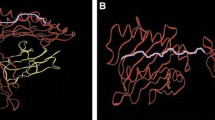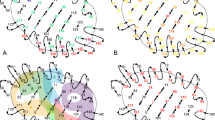Abstract
Knowledge about the magnitude of individual polymorphism is a critical part in understanding the complexity of comprehensive mismatching. HLA-B*44:09 differs from the highly frequent HLA-B*44:02 allele by amino acid exchanges at residues 77, 80, 81, 82 and 83. We aimed to identify the magnitude of these mismatches on the features of HLA-B*44:09 bound peptides since residues 77, 80 and 81 comprise part of the F pocket which determines sequence specificity at the pΩ position of the peptide. Using soluble HLA technology we determined >200 individual (nonduplicate) self-peptides from HLA-B*44:09 and compared their features with that of the published peptide features of HLA-B*44:02. Both alleles illustrate an anchor motif of E at p2. In contrast to the C-terminal peptide binding motif of B*44:02 (W, F, Y or L), B*44:09-derived peptides are restricted predominantly to L or F. The source of peptides for both alleles is identical (LCL 721.221 cells) allowing us to identify 23 shared peptides. The majority of these peptides however contained the restricted B*44:09 anchor motif of F or L at the pΩ position. Molecular modelling based on the B*44:02 structure highlights that the differences of the C-terminal peptide anchor between both alleles can be explained primarily by the B*44:0281Ala > B*44:0981Leu polymorphism which restricts the size of the amino acid that can be accommodated in the F pocket of B*44:09. These results highlight that every amino acid substitution has an impact of certain magnitude on the alleles function and demonstrate how surrounding residues orchestrate peptide specificity.


Similar content being viewed by others
References
Bade-Doeding C, Cano P, Huyton T, Badrinath S, Eiz-Vesper B, Hiller O, Blasczyk R (2011a) Mismatches outside exons 2 and 3 do not alter the peptide motif of the allele group B*44:02P. Hum Immunol 72:1039–1044
Bade-Doeding C, Huyton T, Eiz-Vesper B, Blasczyk R (2011b) The composition of the F pocket in HLA-A*74 generates C-terminal promiscuity among its bound peptides. Tissue Antigens 78:378–81
Bade-Doeding C, DeLuca DS, Seltsam A, Blasczyk R, Eiz-Vesper B (2007) Amino acid 95 causes strong alteration of peptide position Pomega in HLA-B*41 variants. Immunogenetics 59:253–259
Bade-Doeding C, Elsner HA, Eiz-Vesper B, Seltsam A, Holtkamp U, Blasczyk R (2004) A single amino-acid polymorphism in pocket A of HLA-A*6602 alters the auxiliary anchors compared with HLA-A*6601 ligands. Immunogenetics 56:83–88
Badrinath S, Huyton T, Schumacher H, Blasczyk R, Bade-Doeding C (2012a) Position 45 influences the peptide binding motif of HLA-B*44:08. Immunogenetics 64:245–9
Badrinath S, Saunders P, Huyton T, Aufderbeck S, Hiller O, Blasczyk R, Bade-Doeding C (2012b) Position 156 influences the peptide repertoire and tapasin dependency of human leukocyte antigen B*44 allotypes. Haematologica 97:98–106
Barnstable CJ, Bodmer WF, Brown G, Galfre G, Milstein C, Williams AF, Ziegler A (1978) Production of monoclonal antibodies to group A erythrocytes, HLA and other human cell surface antigens-new tools for genetic analysis. Cell 14:9–20
Belich MP, Trowsdale J (1995) Proteasome and class I antigen processing and presentation. Mol Biol Rep 21:53–6
Blanco-Gelaz MA, Suarez-Alvarez B, Diaz-Pena R, Lopez-Larrea C (2009) HLA-B27 polymorphism at position 116 critically influences the association with TAP/tapasin, intracellular trafficking and conformational homodimers formation. Mol Immunol 46:1304–11
Brodsky FM, Parham P, Barnstable CJ, Crumpton MJ, Bodmer WF (1979) Monoclonal antibodies for analysis of the HLA system. Immunol Rev 47:3–61
Chelvanayagam G (1996) A roadmap for HLA-A, HLA-B, and HLA-C peptide binding specificities. Immunogenetics 45:15–26
Elamin NE, Bade-Doeding C, Blasczyk R, Eiz-Vesper B (2010) Polymorphism between HLA-A*0301 and A*0302 located outside the pocket F alters the POmega peptide motif. Tissue Antigens 76:487–90
Fleischhauer K, Kernan NA, O'Reilly RJ, Dupont B, Yang SY (1990) Bone marrow-allograft rejection by T lymphocytes recognizing a single amino acid difference in HLA-B44. N Engl J Med 323:1818–22
Frahm N, Yusim K, Suscovich TJ, Adams S, Sidney J, Hraber P, Hewitt HS, Linde CH, Kavanagh DG, Woodberry T, Henry LM, Faircloth K, Listgarten J, Kadie C, Jojic N, Sango K, Brown NV, Pae E, Zaman MT, Bihl F, Khatri A, John M, Mallal S, Marincola FM, Walker BD, Sette A, Heckerman D, Korber BT, Brander C (2007) Extensive HLA class I allele promiscuity among viral CTL epitopes. Eur J Immunol 37:2419–33
Guex N, Peitsch MC (1997) SWISS-MODEL and the Swiss-PdbViewer: an environment for comparative protein modeling. Electrophoresis 18:2714–23
Hillen N, Mester G, Lemmel C, Weinzierl AO, Muller M, Wernet D, Hennenlotter J, Stenzl A, Rammensee HG, Stevanovic S (2008) Essential differences in ligand presentation and T cell epitope recognition among HLA molecules of the HLA-B44 supertype. Eur J Immunol 38:2993–3003
Hirosawa M, Hoshida M, Ishikawa M, Toya T (1993) MASCOT: multiple alignment system for protein sequences based on three-way dynamic programming. Comput Appl Biosci 9:161–7
Lemmel C, Weik S, Eberle U, Dengjel J, Kratt T, Becker HD, Rammensee HG, Stevanovic S (2004) Differential quantitative analysis of MHC ligands by mass spectrometry using stable isotope labeling. Nat Biotechnol 22:450–4
Macdonald WA, Chen Z, Gras S, Archbold JK, Tynan FE, Clements CS, Bharadwaj M, Kjer-Nielsen L, Saunders PM, Wilce MC, Crawford F, Stadinsky B, Jackson D, Brooks AG, Purcell AW, Kappler JW, Burrows SR, Rossjohn J, McCluskey J (2009) T cell allorecognition via molecular mimicry. Immunity 31:897–908
Macdonald WA, Purcell AW, Mifsud NA, Ely LK, Williams DS, Chang L, Gorman JJ, Clements CS, Kjer-Nielsen L, Koelle DM, Burrows SR, Tait BD, Holdsworth R, Brooks AG, Lovrecz GO, Lu L, Rossjohn J, McCluskey J (2003) A naturally selected dimorphism within the HLA-B44 supertype alters class I structure, peptide repertoire, and T cell recognition. J Exp Med 198:679–91
Peh CA, Burrows SR, Barnden M, Khanna R, Cresswell P, Moss DJ, McCluskey J (1998) HLA-B27-restricted antigen presentation in the absence of tapasin reveals polymorphism in mechanisms of HLA class I peptide loading. Immunity 8:531–42
Rao X, Hoof I, Costa AI, van Baarle D, Kesmir C (2011) HLA class I allele promiscuity revisited. Immunogenetics 63:691–701
Saper MA, Bjorkman PJ, Wiley DC (1991) Refined structure of the human histocompatibility antigen HLA-A2 at 2.6 A resolution. J Mol Biol 219:277–319
Theodossis A, Guillonneau C, Welland A, Ely LK, Clements CS, Williamson NA, Webb AI, Wilce JA, Mulder RJ, Dunstone MA, Doherty PC, McCluskey J, Purcell AW, Turner SJ, Rossjohn J (2010) Constraints within major histocompatibility complex class I restricted peptides: presentation and consequences for T-cell recognition. Proc Natl Acad Sci U S A 107:5534–9
Acknowledgments
The technical assistance of Susanne Aufderbeck is gratefully acknowledged. This work was supported by a grant from the German Federal Ministry of Education and Research (reference number 01E00802).
Author information
Authors and Affiliations
Corresponding author
Electronic Supplementary Materials
Below is the link to the electronic supplementary material.
ESM 1
(DOC 77 kb)
Rights and permissions
About this article
Cite this article
Huyton, T., Schumacher, H., Blasczyk, R. et al. Residue 81 confers a restricted C-terminal peptide binding motif in HLA-B*44:09. Immunogenetics 64, 663–668 (2012). https://doi.org/10.1007/s00251-012-0625-1
Received:
Accepted:
Published:
Issue Date:
DOI: https://doi.org/10.1007/s00251-012-0625-1




